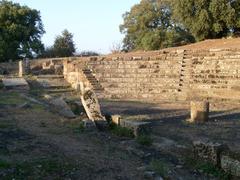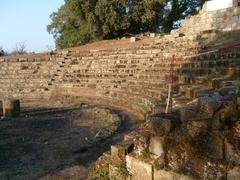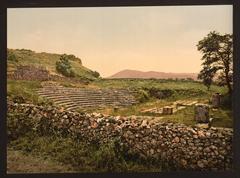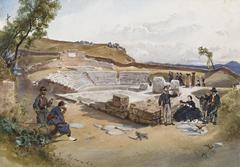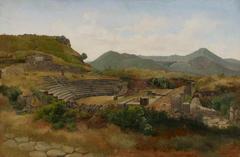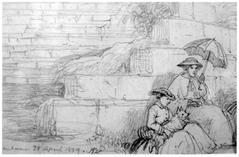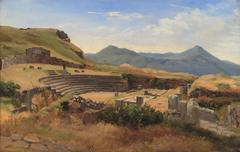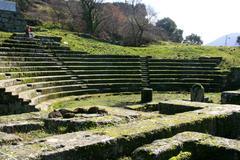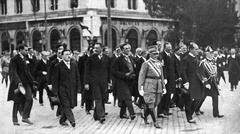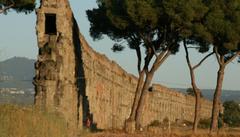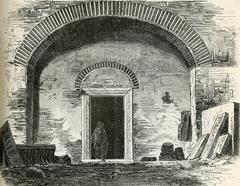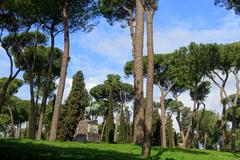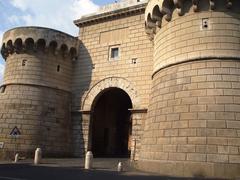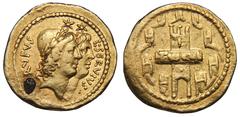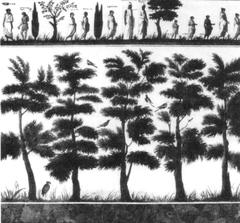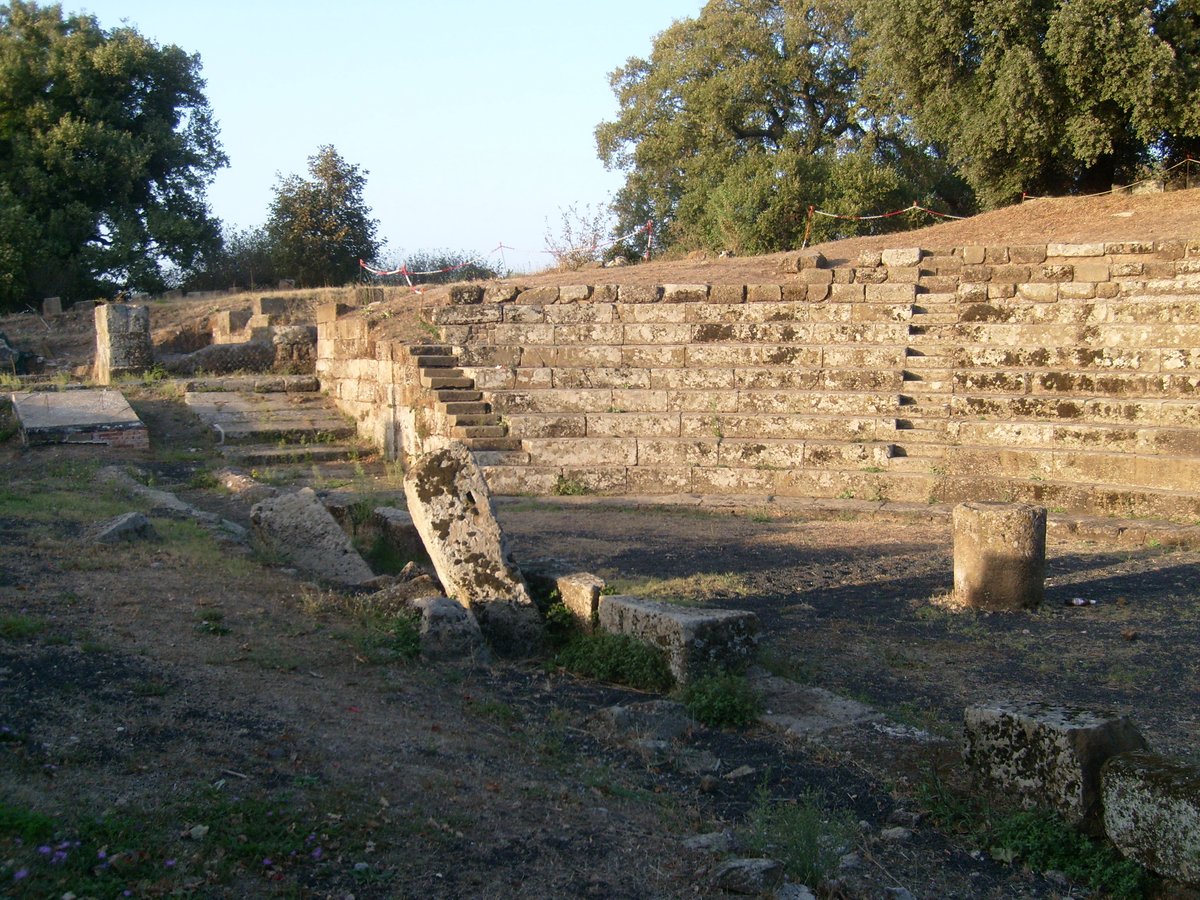
Roman Theatre of Tusculum: Visiting Hours, Tickets, and Historical Sites in Grottaferrata, Italy
Date: 14/06/2025
Introduction
Nestled amidst the scenic Alban Hills near Grottaferrata, the Roman Theatre of Tusculum stands as a remarkable testament to Roman architectural mastery and cultural vibrancy. Dating to the late 1st century BCE or early 1st century CE, this ancient theatre was not only a venue for performances but also a hub for political gatherings and religious festivals, reflecting the dynamic social fabric of ancient Tusculum—an influential Latin city favored by notable Romans such as Cicero and Lucullus.
The theatre is now the centerpiece of an extensive archaeological park within the picturesque Castelli Romani region, renowned for its rolling hills, lush woodlands, and rich culinary traditions. Visitors to Tusculum can explore the theatre’s semicircular cavea, orchestra, and stage, as well as nearby archaeological remains such as the forum, city walls, amphitheater, and necropolises. Panoramic views stretch across Lazio, reaching as far as Rome and the Tyrrhenian Sea on clear days, enriching every visit with natural beauty.
This detailed guide offers essential information on visiting hours, tickets, guided tours, accessibility, and nearby attractions, ensuring your experience at the Roman Theatre of Tusculum is both immersive and seamless. For the latest updates and travel resources, consult the Castelli Romani tourism portal and the Tusculum Archaeological Park website. For enriched, on-site exploration, audio guides are available via the Audiala app.
Historical Overview
Origins and Cultural Significance
Tusculum’s origins stretch back to the Iron Age, with legendary roots attributed to Telegonus, son of Ulysses and Circe (Museum Grand Tour). The city flourished as a key member of the Latin League before integrating into Rome after the Battle of Lake Regillus in 496 BC (Italiani.it). In the Republican and Imperial eras, Tusculum became a preferred retreat for the Roman elite, with Cicero, Sulla, and Tiberius among its distinguished residents. Cicero famously wrote his “Tusculanae Disputationes” here (Lazio Nascosto).
The Roman Theatre, constructed in the first half of the 1st century BCE, was central to city life, accommodating up to 2,000 spectators and hosting a vibrant array of performances and public events (Turismo Roma). The city endured decline after the Empire’s fall, with its final destruction in 1191, but centuries of archaeological efforts have revived its monumental legacy (Museum Grand Tour).
Architectural Features
Ingenious Design and Layout
- Hillside Integration: The theatre is expertly embedded into the natural slope, optimizing acoustics and structural stability—a hallmark of Roman engineering (Visit Castelli Romani).
- Capacity: With seating for approximately 2,000, the theatre features a semicircular cavea, divided into tiers for distinct social classes.
- Orchestra and Stage: The orchestra, reserved for important guests, and the raised stage (pulpitum) are still visible, although much of the original marble cladding and statuary is lost.
- Construction Techniques: Roman concrete (opus caementicium) and opus reticulatum stonework underpin the structure, with vaulted corridors and staircases ensuring smooth crowd flow.
Panoramic Setting
The theatre’s elevated location affords sweeping views of the Valle Latina, Monte Cavo, and the Tyrrhenian Sea, enhancing both the audience’s experience and the site’s enduring appeal (Turismo Roma).
Cultural and Social Role
- Performance Hub: The theatre hosted comedies, tragedies, and possibly mime shows, sponsored by local elites as acts of public benefaction.
- Civic Center: It also functioned as a venue for political assemblies and public announcements, underscoring its importance in Tusculum’s urban life (Visit Castelli Romani).
- Modern Revival: Today, the theatre is a venue for cultural events like the “Le Tuscolane” school festival and summer concerts, rekindling its ancient spirit (Italiani.it).
Archaeological Park and Surroundings
Other Monuments
Beyond the theatre, the archaeological park preserves:
- Forum and Basilica: The civic heart, with remnants of public buildings and temples.
- City Walls and Gates: Ancient fortifications still partially visible.
- Amphitheatre: The elliptical outline is discernible, though less well-preserved.
- Via dei Sepolcri: An ancient road lined with tombs, offering insight into Roman funerary customs.
- Residential and Sacred Areas: Excavations reveal patrician houses, cisterns, and sanctuaries.
Trails are well-marked, and interpretive panels in Italian and English aid exploration (Touristlink).
Integration with Castelli Romani
The park is close to charming towns such as:
- Frascati: Known for white wine and Renaissance villas.
- Grottaferrata: Home to the Abbey of San Nilo, an important medieval landmark (Visit Castelli Romani).
- Monte Porzio Catone: Offers access to hiking trails connecting to Tusculum.
The region is ideal for combining archaeological visits with local cuisine, wine tasting, and outdoor activities (Turismo Roma).
Practical Information
Location and Access
- By Car: Take the GRA to exit 20-21, then Via Anagnina (SP511) to Grottaferrata; follow signs to the park (Mondovagando Senzameta).
- By Public Transport: Train from Roma Termini to Frascati, then local bus or taxi to the park (Audiala).
Opening Hours
- General Hours: Saturdays and Sundays, 10:00 AM until dusk. Weekdays by reservation only.
- Seasonal Closures: The park is closed in December and January.
- Check for Updates: Hours may vary; always confirm on the official park website (Museum Grand Tour).
Ticket Prices
- Standard Entry: €3.00
- Reduced (children 7–12): €2.00
- Guided Tour: €5.00 (€2.00 for children 7–12)
- Free Entry: Children under 6 and visitors with disabilities (Lazio Nascosto)
Booking: Recommended for guided tours and weekdays. Reserve via phone/WhatsApp: +39 391 4225048 or email: [email protected] / [email protected].
Guided Tours
- Available May to September by reservation.
- Tours last around one hour and offer valuable historical context (Visit Castelli Romani).
Facilities
- Parking: On-site, near the park entrance.
- Restrooms: Available at the visitor center.
- Café/Bar: Light refreshments.
- Playground and Picnic Area: Family friendly (Italiani.it).
Accessibility
- Some areas have uneven terrain and ancient paving; wear sturdy shoes.
- Wheelchair access is limited; contact management for support (Turismo Roma – Accessibility).
Visitor Tips
- Best Seasons: Spring and autumn for mild weather and vibrant landscapes.
- What to Bring: Water, sun protection, camera, and comfortable shoes.
- Events: Look for seasonal performances, concerts, and special astronomy nights (“The Sky of Tusculum”) for a unique experience (Italiani.it).
- Sustainability: Respect the protected natural area and archaeological remains.
Frequently Asked Questions (FAQ)
Q: What are the opening hours?
A: Saturdays and Sundays from 10:00 AM until dusk; weekdays by reservation. Closed December and January.
Q: How much are tickets?
A: €3.00 standard, €2.00 reduced, free for children under 6 and visitors with disabilities. Guided tours are €5.00.
Q: Are guided tours available?
A: Yes, by reservation from May to September, lasting about one hour.
Q: Is the site accessible?
A: Terrain is uneven; wheelchair access is limited. Contact management for details.
Q: What is the best time to visit?
A: Spring and autumn for pleasant weather and fewer crowds.
Q: Can I combine my visit with other sites?
A: Yes, nearby attractions include Grottaferrata Abbey, Frascati’s villas, and the amphitheatre.
Visuals and Media
- Browse official images and virtual tours on the Tusculum Archaeological Park website.
- Look for alt-tagged photos like “Roman Theatre of Tusculum archaeological site” and “Castelli Romani historical sites panorama.”
- Maps and interactive guides are available via the Audiala app.
Further Exploration
Conclusion
The Roman Theatre of Tusculum offers a captivating blend of history, architecture, and natural beauty within the enchanting Castelli Romani hills. With clear visiting hours, affordable tickets, and enriching guided tours, the site welcomes all—from history buffs to families and hikers. Enhance your journey with digital resources like the Audiala app and stay connected through official tourism portals for news and events. Take the opportunity to explore nearby towns, sample regional wines, and immerse yourself in central Italy’s cultural heart.
For the latest updates, visit the Castelli Romani tourism portal and the Tusculum Archaeological Park official site.
